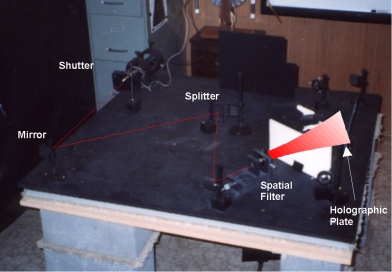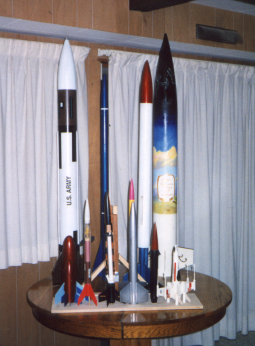In the early 1960s Holography emerged as one of the most exotic uses of the unique light produced by lasers. By the early 1970s it began to make the transition from scientist only to hobbyist. At first it was to exploit it as an artistic medium but the amateurs that saw its potential quickly developed innovations of media and techniques that became main-stream.
By the mid 1990s the nascent “World Wide Web” had one or two Usenet newsgroups called alt.holography dedicated to the hobby. Between this and a couple of “how-to” books published by the 1970s superstars of the San Francisco Holography Art movement everyone had access to the technology.
The hardware came available with affordable Kodak holography plates and the surplus lasers from copy machines made the hobby approachable to interested amateurs. 
My holography table was built from the aft bulkhead of a 747 from Boeing Surplus which is a two-inch high honey-comb sandwiched between two aluminum sheets. I added padding and bricks and placed it in my basement.
In the configuration seen in the pictures it is making a reflection hologram of some plaster whales. One beam illuminates the whales, while the other illuminates the plate at the far right.
As y ou can see, this is all stuff hacked together from scraps.
ou can see, this is all stuff hacked together from scraps.
 Federal Aviation Administration and the Bureau of Alcohol, Tobacco and Firearms provided strict regulations around the storage, purchase and use of any rocket motors with a specific impulse above 36 Lb-seconds. In order to better assure that the hobbyist would align with these regulations, hobbyists associations coordinate the launches and supply amateurs with the supplies and training they need.
Federal Aviation Administration and the Bureau of Alcohol, Tobacco and Firearms provided strict regulations around the storage, purchase and use of any rocket motors with a specific impulse above 36 Lb-seconds. In order to better assure that the hobbyist would align with these regulations, hobbyists associations coordinate the launches and supply amateurs with the supplies and training they need. Mine was a pic-based system with a clunky altimeter and an enormous T-1 accelerometer but what I really wanted to study was what’s called the mach disks of the rocket’s exhaust. This is actually a phenomena that reveals volumes about the sonics, plasma and nozzles of all jet and rocket propulsion.
Mine was a pic-based system with a clunky altimeter and an enormous T-1 accelerometer but what I really wanted to study was what’s called the mach disks of the rocket’s exhaust. This is actually a phenomena that reveals volumes about the sonics, plasma and nozzles of all jet and rocket propulsion.
Recent Comments